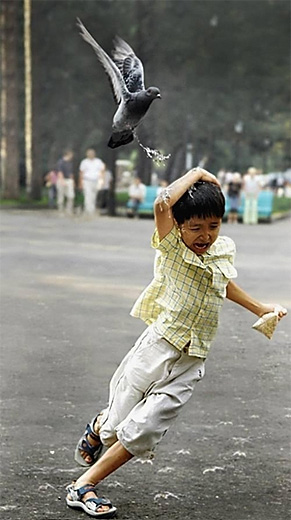anchor
It looks like 10 000 000 000 pounds of crap in a 10 pound bag

The reasons why pigeons were brought along, as people moved across the globe to set up new settlements, are owing to the value that pigeon once served as a source of food and a source of fertilizer. Both squab and pigeon eggs are still eaten in many places, and are considered a delicacy. Pigeon excrement is a highly-prized material, rich in both phosphorous and nitrogen, that was once commonly used to improve the soil of fallow land, as well as processed to make gunpowder.
According to this news report distributed in 2007, it is expected that, as urbanization continues to grow, the world wide pigeon population will increase from 50 million to 400 million over the next ten years. It has been estimated that there is over one million pigeons living in the city of New York, which means that there is one bird for every eight human inhabitants. The highest density of pigeons is in Venice, where there are three pigeons for every individual city-dweller. The world wide average is estimated to be about one pigeon for every 20 people.
The main complaint about the bird is the amount of excrement that is produced by the population. It has been said that each pigeon will produce 25 pounds of excrement every year. As a result, in New York, there would be over 25 million pounds of pigeon excrement produced every year and spread across the city. In Venice, 1.2 billion [yes, with a “B”!] pounds of excrement is produced every year and decorate the streets and buildings.
Oh somebody help us! We are going to be drowning in it by 2020!
The biogeographer Ian G. Simmons once wrote “The flows of energy and mineral nutrients through an ecosystem manifest themselves as actual animals and plants of a particular species.” This quote can be found in Manuel De Landa’s A Thousand Years of Nonlinear History. In the same paragraph, De Landa wrote “In many respects, it is the circulation that matters, not the particular forms that cause it to emerge.”
With this in mind, perhaps we could begin to concentrate our efforts on putting seemingly toxic and unpleasant material into circulation as quickly as possible, rather than focus our energy on getting rid of the source. In contemporary ecological discourse, there is much talk of limited resources. In this light, it might seem hypocritical, and perhaps an example of a fault with the “dominate western world view” that Richard Johnston suggested [even ASPCA is willing to ignore the issue], to argue for the elimination of productive pigeons.
It seems they are overlooking the value that can be found in the offensive material. Pigeon guano, in agricultural applications, can be used as a soil builder, lawn treatment, fungicide [when fed to plants through the leaves], nematicide [decomposing microbes help control nematodes], and as composting activator [nutrients and microbes speed up decomposition].
As the human population swells, and is expected to reach 9 billion by 2040, one of the main problems to solve for future generations will be about providing food to everyone using only the limited amount of resources and land available. This will require cultivation processes to work with maximum efficiency and economy. As a result, I would begin to wonder if we might be able to revert back to one of the original uses that gave the pigeon value and use the abundance of dung in a manner quite familiar to the generations of human beings that have preceded us. Seemingly, our progenitors knew what to do with very little and perhaps there might be some lessons in that history.
In considering circulation as key to understand both natural and artificial ecosystems, it might be interesting to imagine a microcosm whose inhabitants are both people and pigeons that orbit restaurants that are located in the city and are also located near their crops. As a generalized and idealized outline of the happenings there, perhaps this loop could develop: restaurant feeds people à people feed pigeons à pigeons feed crops à crops feed restaurant à [ad infinitum]


No Comments
Block this user
Are you sure you want to block this user and hide all related comments throughout the site?
Archinect
This is your first comment on Archinect. Your comment will be visible once approved.